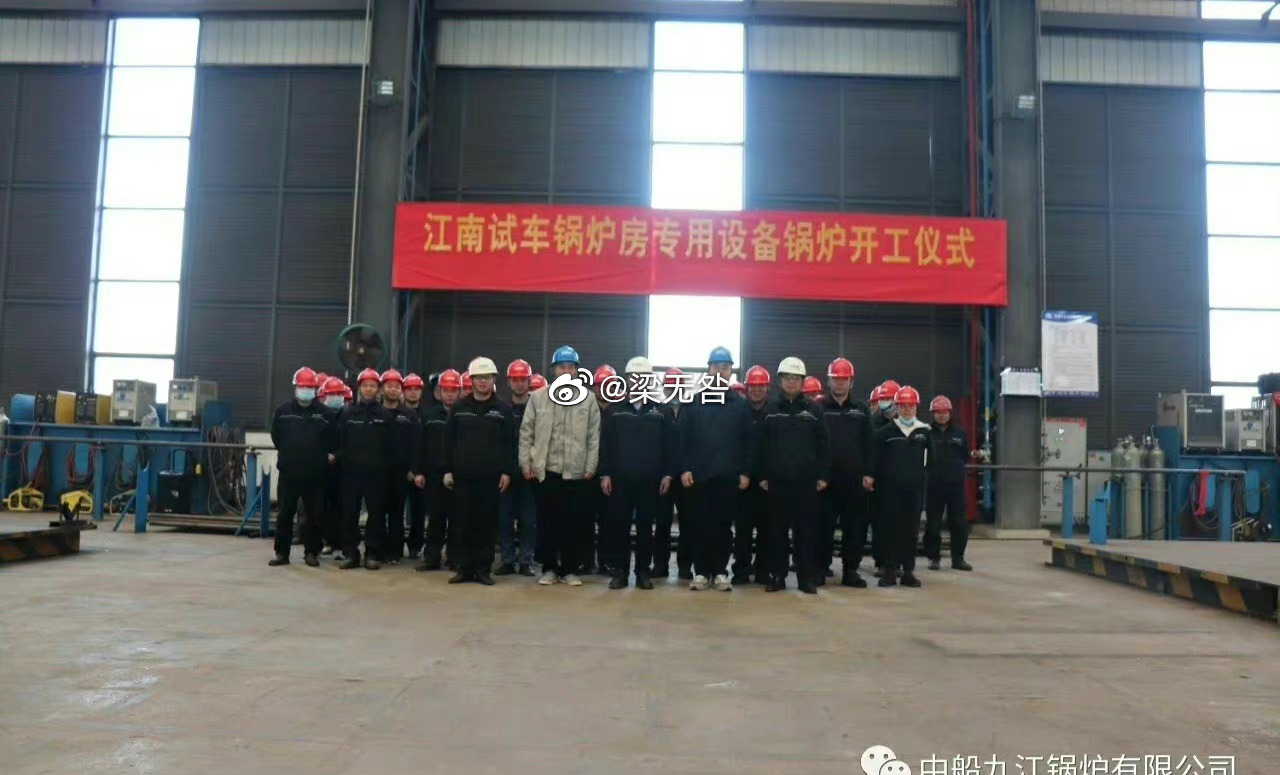You are using an out of date browser. It may not display this or other websites correctly.
You should upgrade or use an alternative browser.
You should upgrade or use an alternative browser.
00X/004 future nuclear CATOBAR carrier thread
- Thread starter AETHER
- Start date
by78
General
For what is worth, Jiangnan is building a dedicated onshore boiler testing facility. This facility will allegedly be used to verify the steam supply system of China's carrier nuclear reactors. The test boilers will be able to generate enough steam and steam pressure to test the bearing capacity of various pipes and valves as well as the steam turbines destined for the nuclear carrier.


Going back earlier, in May of 2020, the top leadership of Jiangnan shipyard paid a visit to Bohai shipyard to conduct detailed exchanges on product development and personnel training, etc. The visit follows up on earlier exchanges between the two shipyards.
Of course, Bohai has a lot of experience building nuclear-powered submarines. Jiangnan has no experience with nuclear power plants.





Going back earlier, in May of 2020, the top leadership of Jiangnan shipyard paid a visit to Bohai shipyard to conduct detailed exchanges on product development and personnel training, etc. The visit follows up on earlier exchanges between the two shipyards.
Of course, Bohai has a lot of experience building nuclear-powered submarines. Jiangnan has no experience with nuclear power plants.



Last edited:
Keep in mind that WTI price in the late 90s were around $20 and now they are at $110. It's certainly possible that the era of high gas price is here with no retreating to even $60 a barrel. Therefore, the operating cost for a conventionally powered carrier that's built today should be higher than that of a nuclear powered one. Also on top of this, there is a certain factor that would favor the theory of lower ratio in Chinese construction cost of CVN vs CV. China has the largest active program of SMR in the world for civilian power and will rapidly ramp up its nuclear submarine construction in the next 20 years. As such, it might be able to achieve economy of scale on small nuclear reactors that other countries who have used marine nuclear reactors have been unable to do. I think it's reasonable to assume that a Chinese CVN would be more expensive, larger and more capable than a conventional powered CV. I just don't know if we can get an accurate gage of how much more expensive. I think if the lifetime costs are 25 to 50% more expensive, it would still be worth it.
I also think it's a bad idea to believe that somehow USN have had higher CVN cost because it's stupid or wasteful. USN carrier is the golden standard that PLAN has been learning from.
Aside from being able to carry more aircraft, more aviation fuel and generally have more space than conventional aircraft, there are also a lot of general operational advantages for CVN. You don't have to worry about refueling them on a long deployment or in a war scenario, so they can sustain operation even if China get its energy route cut off from Middle East or foreign ports refuse to allow them to be refueled.
It's not just SMRs. The level of nuclear expertise in China in general is much higher than in the US.
China has a number of different reactor designs in serial production.
The current plan (now underway) is 150 reactors over the next 15 years, which works out as 10 per year.
It's gotten to the point where costs and construction timescales have standardised at approximately $2000/MW and a 5 year construction period.
So I wouldn't be surprised if Chinese aircraft carrier reactors in cost half as much as the US equivalent.
They are also building nuclear powered ice breakers (sans reactor) and floating reactors as well as related supporting infrastructure and talents.
How much would China have to reduce the cost per MW to make nuclear competitive for cargo operations? Or, is that just not realistic?
How much would China have to reduce the cost per MW to make nuclear competitive for cargo operations? Or, is that just not realistic?
How about nuclear powered cruisers? Granted it's not a new idea. The US navy used to have nuclear cruisers but concluded that they were not cost effective. However that conclusion was based on 1970's era technology. Do nuclear powered cruisers make sense today, I don't know?They are also building nuclear powered ice breakers (sans reactor) and floating reactors as well as related supporting infrastructure and talents.
How much would China have to reduce the cost per MW to make nuclear competitive for cargo operations? Or, is that just not realistic?
Eh, why go for that, when they could build more 055s or whatever the successor for the 052D is.How about nuclear powered cruisers? Granted it's not a new idea. The US navy used to have nuclear cruisers but concluded that they were not cost effective. However that conclusion was based on 1970's era technology. Do nuclear powered cruisers make sense today, I don't know?
Afterall the larger the platform, the less it can be mass produced as well as more asset and value in one piece of equipment.
What's more, don't we like have leaks/estimates that going from the ~7000k tons 052D to 13k tons 055 was like a doubling in price?
So an even larger, say 20k or more cruiser would probably be at least a doubling of the 055.
Moreover, western countries designate the 055 as being a cruiser, and I don't really fault them on that.
On nuclear-powered Cruisers, I wrote yesterday: CV-18 Fujian/003 CATOBAR carrier thread
broadsword
Brigadier
Keep in mind that WTI price in the late 90s were around $20 and now they are at $110. It's certainly possible that the era of high gas price is here with no retreating to even $60 a barrel. Therefore, the operating cost for a conventionally powered carrier that's built today should be higher than that of a nuclear powered one. Also on top of this, there is a certain factor that would favor the theory of lower ratio in Chinese construction cost of CVN vs CV. China has the largest active program of SMR in the world for civilian power and will rapidly ramp up its nuclear submarine construction in the next 20 years. As such, it might be able to achieve economy of scale on small nuclear reactors that other countries who have used marine nuclear reactors have been unable to do. I think it's reasonable to assume that a Chinese CVN would be more expensive, larger and more capable than a conventional powered CV. I just don't know if we can get an accurate gage of how much more expensive. I think if the lifetime costs are 25 to 50% more expensive, it would still be worth it.
I also think it's a bad idea to believe that somehow USN have had higher CVN cost because it's stupid or wasteful. USN carrier is the golden standard that PLAN has been learning from.
Aside from being able to carry more aircraft, more aviation fuel and generally have more space than conventional aircraft, there are also a lot of general operational advantages for CVN. You don't have to worry about refueling them on a long deployment or in a war scenario, so they can sustain operation even if China get its energy route cut off from Middle East or foreign ports refuse to allow them to be refueled.
So has the price of uranium gone up, from about $10 in the late 90s to about $50 today.
Guys, IMHO we should take one step back to see the bigger picture then we probably could come to a conclusion on what kind of carrier PLAN need next.
On an official term, what is "the mission this generation of Chinese must accomplish"? Obviously it is so called the reunification of motherland.
Who's responsibility it is? My money is on President Xi and his administration.
President Xi is approaching his 70th birthday next year, and rumor says (and I am not responsible for this rumor) he is looking for one more term (5 years) in the office. By then he is approaching 75 and probably would not take another term (just see how Joe Biden is doing in his late 70s & early 80s).
If all above were true, then the year 2027 is a critical milestone to achieve the target of reunification of motherland aca. recover Taiwan.
To achieve this target, what arm forces PLAN need? Would 3 carriers (CV-16, CV-17 & CV-18) together with the Rocket Army be enough to deter potential hostiles approaching 500nm to the east of the island?
Here are my assumptions:
1. Carriers, no matter which one, is not aiming Taiwan. PLAAF alone is enough to obtain a full control of air dominance over the island.
2. The soul purpose of these carriers is to cruise at the east of the island preparing for any hostile movement from West Pacific and South Sea. Based on the principle of 料敌从宽 it is capable to estimate the amount of fleets coming for raid.
3. In this case the endurance of carrier is not a key factor, but probably the number of carried flights.
4. Furthermore as the technical evolving philosophy of PLAN is, as so many people mentioned, 小步快跑, which means huge pace of technical development under time pressure is unlikely to happen, especially in front of this tremendous strategic target.
So jump to the conclusion, the #4 carrier (not Type 004) would probably be similar to CV-18 with improvements preparing for future CVN about to come.
Though I am happy to be proven wrong which would only indicating one thing but only:
The PLAN is not going to passively respond to hostile movements during the recover progress of Taiwan but push the line further, deep into Pacific.
All of us will see this coming.
On an official term, what is "the mission this generation of Chinese must accomplish"? Obviously it is so called the reunification of motherland.
Who's responsibility it is? My money is on President Xi and his administration.
President Xi is approaching his 70th birthday next year, and rumor says (and I am not responsible for this rumor) he is looking for one more term (5 years) in the office. By then he is approaching 75 and probably would not take another term (just see how Joe Biden is doing in his late 70s & early 80s).
If all above were true, then the year 2027 is a critical milestone to achieve the target of reunification of motherland aca. recover Taiwan.
To achieve this target, what arm forces PLAN need? Would 3 carriers (CV-16, CV-17 & CV-18) together with the Rocket Army be enough to deter potential hostiles approaching 500nm to the east of the island?
Here are my assumptions:
1. Carriers, no matter which one, is not aiming Taiwan. PLAAF alone is enough to obtain a full control of air dominance over the island.
2. The soul purpose of these carriers is to cruise at the east of the island preparing for any hostile movement from West Pacific and South Sea. Based on the principle of 料敌从宽 it is capable to estimate the amount of fleets coming for raid.
3. In this case the endurance of carrier is not a key factor, but probably the number of carried flights.
4. Furthermore as the technical evolving philosophy of PLAN is, as so many people mentioned, 小步快跑, which means huge pace of technical development under time pressure is unlikely to happen, especially in front of this tremendous strategic target.
So jump to the conclusion, the #4 carrier (not Type 004) would probably be similar to CV-18 with improvements preparing for future CVN about to come.
Though I am happy to be proven wrong which would only indicating one thing but only:
The PLAN is not going to passively respond to hostile movements during the recover progress of Taiwan but push the line further, deep into Pacific.
All of us will see this coming.
When did this onshore boiler testing facility commence construction? Looks like 2020 written on the back?For what is worth, Jiangnan is building a dedicated onshore boiler testing facility. This facility will allegedly be used to verify the steam supply system of China's carrier nuclear reactors. The test boilers will be able to generate enough steam and steam pressure to test the bearing capacity of various pipes and valves as well as the steam turbines destined for the nuclear carrier.


On a side note, seeing the establishments of cooperation between Jiangnan and Dalian on nuclear propulsion system technology, I believe we can be confident that China will be capable of building not one, but TWO nuclear-powered supercarriers - BOTH at the same time in the coming future.
This is a very excellent development for the PLAN and China.
